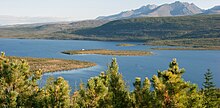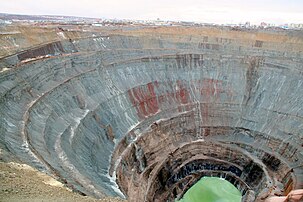| Sacha-Yakutia | |
 | |
Location .svg/250px-Sakha_in_Russia_(crop).svg.png) | |
Coat of arms and flag .svg/70px-Coat_of_Arms_of_Sakha_(Yakutia).svg.png) | |
| State | Russia |
|---|---|
| Region | Southern Russia |
| Capital | Yakutsk |
| Surface | 3,083,523 km² |
| Inhabitants | 956.712 (2015 census) |
| Institutional website | |
Sacha-Yakutia or Republic of Sacha (Yakutia), (Республика Саха (Якутия)) is a region of the Russia.
To know
Geographical notes

The vast territory of this region (more than 3 million km²) makes it the largest administrative unit in the world. It includes the eastern part of the Central Siberian plateau, the Verchojansk and Čerskij mountains and a section of the Stanovoj; from the hydrographic point of view, the major hydrographic basins affecting the territory are those of the rivers Olenëk, Jana, Indigirka, Lena and Kolyma.
The territory is bordered to the north by a very long coastal strip on the Laptev Sea to the west and the East Siberian Sea to the east; the land borders are shared with the Krasnoyarsk Territory to the west, the Irkutsk and Amur oblasts to the south, the Khabarovsk and Transbajkalia Territories to the east, the Magadan oblast and the Čukotka Autonomous District to the northeast.
When to go
Background
In the thirteenth century the Sacha occupied, in addition to all its current territory, also a part of Central Asia. It was mainly inhabited by hunters and gatherers, whose territories were subsequently conquered by people from Mongolia. They called the indigenous population Sacha population, whose origins are still unknown. In the years preceding the arrival of the Russians, the most widespread ethnic groups in the Lena basin were, in addition to the Yakuts, settled in the middle basin of the Lena between the confluence of the Aldan and that of Viljuj, the Evenks (also called Tungus), settled on a vast territory in the upper Lena basin and some communities of Eveni in the lower course and in the area of the mouth. In the seventeenth century Russian colonization began: the oldest cities of Yakutia (Lensk, Yakutsk, Viljuysk) date back to this period. In the years of the Russian civil war, Yakutia declared itself independent from both Russia and the Republic of Siberia, in alliance with the states of Transbaikalia, Buryatia, and the Ukrainian Republic of the Far East. The Jakut revolt was only put down in 1923. The creation of the Autonomous Soviet Socialist Republic of Yakutia (RSSA Jakuta), within the Russian Soviet Federative Socialist Republic, dates back to April 27, 1922; in the following years there was an impetuous development and a large increase in population (from 287,000 inhabitants in 1926 to 1,099,000 in 1990). [18] The second great wave of city founding dates back to this century, among which the largest are Aldan, Njurba, Mirnyj and Nerjungri.In 1991, with the fall of the Soviet Union, the Republic was renamed with its current name. After the disastrous fall of the Soviet Union, Yakutia (like many other regions of the newly formed Russian Federation) demanded secession from Russia. The citizens of Yakutia claimed their ethnic difference from the Russians, but the real reason they wanted to create an independent Yakutia was the huge reserves of natural gas, hydrocarbons, minerals, stones and timber, which made (and make) the inhabitants of Yakutia. Yakutia among the richest in Russia, with an income 8 times higher than a normal Russian citizen [citation needed]. The independence pressures were stopped almost immediately, recognizing to Yakutia a certain independence from Moscow (obviously within the Russian Federation).
Spoken languages
Although this immense region is not very populated, here you can meet different ethnic groups, each with its own language; it is mainly about Russians is Ukrainian (arrived from the west during the Russian colonization) and of jakuti (the indigenous people, who call themselves sacha), as well as minorities belonging to ethnic groups such as eveni, evenchi, čukči and jukaghiri.
Culture and traditions
Yakutia takes its name from its indigenous people, the Yakut people (in the Jakuto language "sacha" hence the second name). The Jakutis are a population of Turkish origin, and although almost everyone here is now Orthodox Christians, there is no lack of vestiges of their ancestral religion attributable to shamanism. In several areas of the region, the sun, the moon, fire and many other natural elements are worshiped with rituals that are nothing short of picturesque that are enjoying increasing success both among tourists interested in these ancient religions and among many locals who are returning. to the ancient shamanic religion by forming new religious groups.
Territories and tourist destinations
Urban centers
- 1 Aldan (city) (Алдан) - The city was founded in 1923 under the name of Nezametnyj (Russian: Heзaметный) and received the status of a city in 1936; also in this year it was renamed with the name it has today. The city is served by Aldan Airport.
- 2 Yakutsk (Якутск) - Capital of the region and largest port on the Lena River.
- 3 Lensk (Ленск) - The city is home to major diamond mines. Lensk was founded in 1663 under the name of Muchtuja (Russian: Myxтуйа) and in the 19th and 20th centuries it was the site of external political exiles. The city experienced its heyday in the 20th century, when diamond deposits were discovered, and many people moved here to look for work in the mines.
- 4 Mirny (Мирный) - Administrative capital of the ulus (district) Mirninskij. The city is located 820 kilometers west of the capital Yakutsk, on the Ireljach River, and is served by an airport.
- 5 Nerjungri (Нерюнгри) - The city, founded in 1975, has evolved in record time. The city of Nerjungri is served by Čul'man Airport with scheduled flights operated by Russian airlines Aeroflot-Don, KrasAir, Yakutavia.
- 6 Njurba (Нюрба)
- 7 Olëkminsk (Олёкминск)
- 8 Pokrovsk (Покровск) - Pokrovsk was founded by the Cossacks in 1682 with the name of Karaulnyj Mys (in Russian: Kapayлный Mйс).
- 9 Srednekolymsk (Среднеколымск)
- 10 Tommot (Томмот)
- 11 Udačnyj (Удачный)
- 12 Verchojansk (Верхоянск) - A Cossack winter camp dates back to 1638, founded about ninety kilometers southwest of the modern town; city status came in 1817.
- 13 Viljuysk (Вилюйск) - Viljuysk was founded in 1634 as a Cossack winter settlement, with the name of Tyukanskoe (in Russian: Tйukанское?) And later renamed with its current name.
Other destinations
- 1 Bennett's Island (Остров Беivaliннетта, Ostrov Bennetta)
- 2 Natural Park of the Pillars of the Lena (Лейнские столбыы, Lenskiye Stolby)
- Polo of the Cold
How to get
By plane
The three major airports serving the region are located at Nerjungri, Yakutsk is Mirny.
How to get around
What see
Itineraries

- Street of Kolyma - the name is reminiscent of a famous book of tales of the gulags of Šalamov, The tales of Kolyma. This road, in fact, was built by prisoners of war of the Stalin era and embraces - in evident contrast to its terrible history - wonderful and uncontaminated landscapes. Today, in addition to being an important way of communication between the oblasts of Magadan and this of Jakutia has become an important itinerary capable of combining history and nature.
What to do
At the table
Safety
Other projects
 Wikipedia contains an entry concerning Sacha-Yakutia
Wikipedia contains an entry concerning Sacha-Yakutia Commons contains images or other files on Sacha-Yakutia
Commons contains images or other files on Sacha-Yakutia



